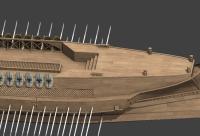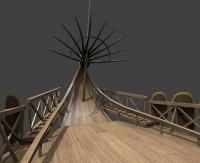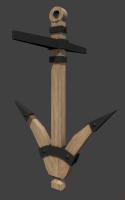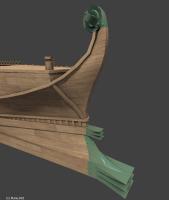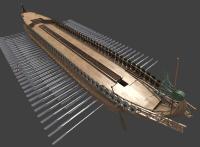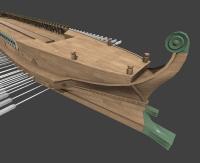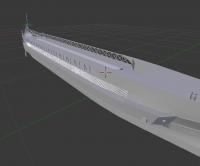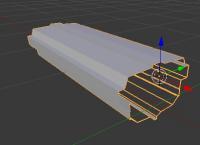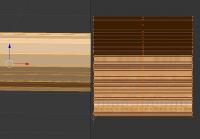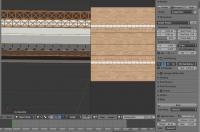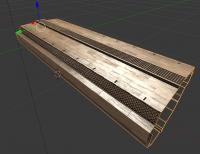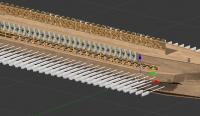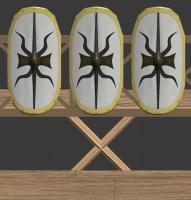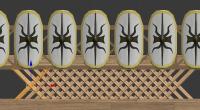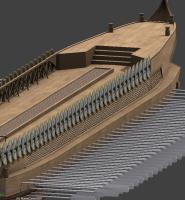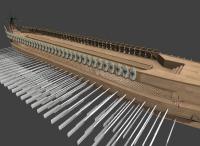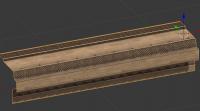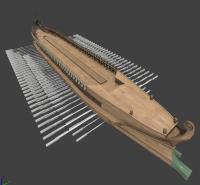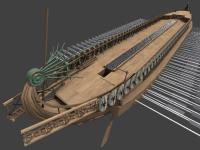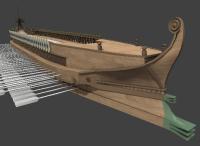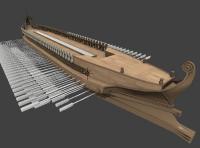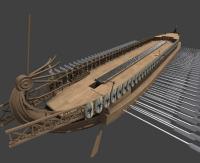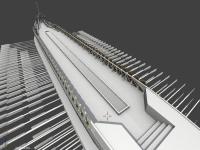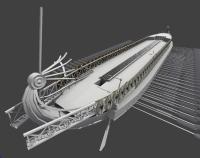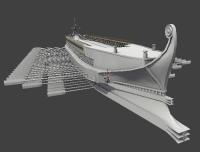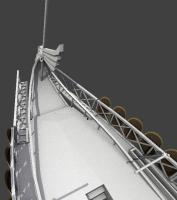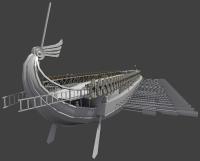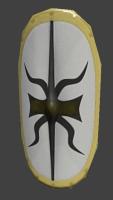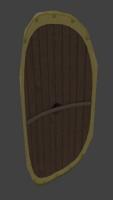
Alpha975
Community Members-
Posts
34 -
Joined
-
Days Won
7
Everything posted by Alpha975
-
This is an awesome idea, indeed Looking very much forward to it! This might be just the thing we need!
-
Thank you very much Yeah, I'm pretty sure one will not get all details right on the first try, so an iterative process with testing and refinement should be employed, until the players like it Oh yea, that is a great idea: just determine rigging based on the distance the ships have to travel. For for voting that would be option D Hm, yea garrisioning siege engines. Here we have the problem that if we allow the player to garrision artillery and it attacking enemy ships, somebody will just take the biggest ship and load it up with ballistas, while the ship itself only has deckspace for, let's say, 2 large artillery pieces. This would also make the player evade the dilemma of choosing between archery towers, boarding equipment or artillery on the ships. Perhaps a way out would be, to indeed allow garrison of artillery, but make it block the slot for the other equiment that could be placed in it. The advantages would be that the only thing modelling wise for this would be to place an empty for the place of the artillery, automatic inclusion of all updates to artillery-pieces (including all balancing) and the historical possibility to unload the artillery. Actually, I like that idea Oh yeah: color-schemes Some of the ships of antiquity were painted really beautifully. I was planing to have the player-colors as the colors of the stripes on the side of the ships. Historically, white was a very popular color for ships and in the roman navy, red and blue were the traditional colors. So I guess ships will become pretty colorful Also, traditionally, a tiny update: Additional attachment points for ropes for rigging and equiment in the front of the roman 5: Tiny details improved at the back of the ship (bronze holder for flag-signal-post and wooden beam for holding the landing-ramps in place): Also, medium quality roman anchor for later baking (looks like at the time wooden anchors with lead weights were the standard for the roman navy):
-
-
Hm, that's a good question. In my opinion, in any case we have to consider the case where players want to play an island map. In this case it is possible that almost all engagements happen at sea. If we still want the game for the players to be fun, we would have to make the naval battles at least as fun and engaging as land battles. So the level of player management and involvement for both should be at the sweetspot (not sure we are at it with the land battles yet ). It should never feel like a hassle, and never make you bored. Generally, we also will always end up with less ships than we would with land units. By that standard we could consider that while land battles might have something like hundreds of units involved, naval battles might only have dozens (as did the largest amount of historical encounters). And additionally, we could introduce more options for micromanagement for naval units. But these options should always remain fun for both players: that is, the player using them and the player having these options used upon himself. I could imagine naval combat as such: Ships can ram, board or perform ranged combat. For boarding you could garrison melee and ranged units on a ship and internally, the ranged and melee soldiers would attack other melee units randomly, and if none are left, ranged units (or something like that). Once the garrison of the ship is gone, it is slowly damaged, set on fire and sinks (could possibly be made to look cool ... yes yes, I know, I' would have to do the animations ...). To initiate boarding, you would simply have to be in range, activate boarding mode, and if you are lucky and roll higher than the defense of the ship being attacked, I could animate hooks being thrown and boarding ramps being employed ... whatever looks cool and historical If you build a ship, it would come without a garrison, and a symbol next to the healthbar would indicate this. The advantage is what a player with an experienced land force could use these experienced soldiers at sea (like the romans ). And landing forces would always have the historical dilemma of possibly leaving the fleet behind unprotected ... The counter for the boarded party could be to "pin" enemy ships by sacrificing ships for boarding and sinking the enemy ships, while their ships are in melee (real, historical tactic ). We would also have the advantage that changes and updates to the land combat would automatically be in naval combat aswell and balanced land forces would automatically go a great length towards balancing naval boarding aswell. Ramming could be made straightforward. And for ranged attacks you would simply have the combined ranged attack of the ship's garrison as one attack, and the attack of the ship's artillery as another one. If it were up to me, I would also allow ships to be specialized. That is: when they are built, they come out plain. If you are in range of a port you could have several slots on your ships, that could be filled with specializations. For instance for a roman 5: 1 slot for the oars: either semi-cataphract (extra speed) or cataphract (extra protection) 1 slot for the belly: either nothing, copper-coating (after it is researched for extra health, but slightly lower speed) of lead-coating (after it is researched for a different amount of extra health, but slightly lower speed) 1 slot for the front of the ship: either nothing, an archery tower (ranged attacks, slightly slower speed), a corvus (after research for extra boarding chance but reduced maneuverability and speed), siege artillery (you guessed it ... research + siege attacks + reduced maneuverability and speed), light artillery (yeah: research + range attacks + slightly reduced maneuverability and speed) or fire pots (extra ram damage after research) or whatever we think of I would also allow ships to only unload troops once they are beached (I could provide animations). There they would have greatly reduced defenses. This would also give an attacked party a longer time to react to a landing and even more awesomely: allow a faction without any navy to destroy the navy of a landing force with melee units if they overwhelm the defending forces (and create some cool looking, burned ships on your beaches ). An interesting possibility that I thought about: ships would actually come in two parts (left and right) both with their own health. They could be damaged individually. The player would only see the one health bar per ship (geometric mean of the two semi-parts ... that is: sqrt(health1*health2) ). The advantage: you could concentrate your damage (ramming) on one, damaged, ship side that you can identify by the damage model. If one side has 0 health, the health bar will also be at 0. Also: if both sides are at 100%, the health bar will be at 100% (isn't math nice ) This would be a nice option that would never bother new players, but experienced players could try to really micromanage their attacks ... could be a lot of fun And in that case again: me -> anmations and damages ships textures I was also thinking about the dilemma of ships with all of their rigging. In combat ships typically did not have their rigging out (there are historical accounts of sea battles where unprepared fleets with sails out were caught and at a great disadvantage in combat). As I see it, there could be three possibilites: A: ships always have their sails out B: ships are always combat ready C: players can switch between the two states with a button press and both have their advantages and disadvantages (in that case I would even go so far as to provide some animations for this ) Ok, that was a massive post. Sorry for that What do you think about all that? And perhaps let us poll the last option. Who would like to see A, B or C?
-
Thank you all very much Good question. I haven't specifically searched for this in the literature, but here is what was in some of the literature I looked through to gain insight into ship-building much later: The first mentions of naval battles were around 3500-3050 BC [2]. If I remember correctly, minoean ships looked pretty much the same, independently of their purpose around 1650-1500 BC [2]. The first ships that could be identified as the predecessors of the later monoremes were developed around 1200 BC in mycenaean greece [1,3] and around the same time there were also depictions of the warships built in egypt and by the sea people together with distinct mentions of both trading and combat ships [2]. The first purpose built variants designed specifically for war might be estimated to be conceived around that time [1,2] though even earlier depictions of ships (1567-1320 BC) show the front and aft platforms of later warships [2]. As far as I know, the earliest direct mention of a ship-attached ram was around the middle of the 8th century BC [1], though it is estimated that it was developed between 1000 and 850 BC [1] or possibly even earlier as a reinvention of bronze age designs [3]. This is roughly also the point where from then on, civil and military naval architecture were no longer similar since a ram requires a strongly reinforced prow and hull [1]. The solution at the time was to make the ships shorter, more robust and equipped with more oars. Increasing the length of ships was not a great option at the time [1]. You can see the two possibilities with the development of the improved penteconter and the bireme. Around that time (second half of the 8th century BC) in the Odyssey there was a distinction between broad freighters with 20 oars and the 50 oared ship that can be seen as a specialization of the previously used ship type(s) [3]. Thucydides implies this "early" pentekonter was used for many tasks, including "convoyance of ambassadors, supression of piracy and, exceptionally, warfare" [3]. Biremes were in use at least since 700 BC [1,2,3] and the penteconter was mentioned (together with other warship types) in Homer's Iliad [2]. The penteconter seems to have been improved into a pure warship by at least the 6th century BC [1,2]. However, the evolution was even more gradual and harder to pin down than these numbers might indicate. The evolution of ships was very slowly with many intermediate steps so that even living at the time would still make it hard to tell in which century and in which region the transition happend, in particular as there are many examples where old designs and technologies were used alongside new ones until the new ones proved more reliable [3]. The issue becomes even more confusing as even at later times warships were often also used as transports and transports as warships [3]. Additionally the sources in the time of interest are very sparse and there is even debate to which extend the knowledge about ship-building from the late bronze age carried over to the early iron age [3]. And even the sources that are available are debated a lot [3]. [1] wikipedia and sources therein. [2] Warships of the Ancient world: 3000-500BC by Adrian K. Wood and sources therein. [3] The age of the galley by Robert Gardiner and sources therein. I hope this small paragraph helps a little
-
Ok, another tiny progress report. Finally, I finished unwrapping the main part of the high poly model. Here is how the model looks like (including a few very tiny changes): Now onto getting a nice version for the game engine So, first part of the low poly model are the rows. Here is a comparison between the high quality model (back, 148 faces, 296 tris), the early, placeholder low poly version (middle, 18 faces, 26 tris) and the new low poly version (front, 12 faces, 20 tris): And after some baking, the new one starts to look passable for its poly-count :
-
Hm, yes. Would be great if somebody would help with coding. Some more UV unwrapping and detail-work on the high poly model:
-
Thank you very much Yes, if the coding supported this, we could even give the player a toggle button, where he/she could raise or lower sails depending on whether extra speed or extra ship defense was needed. That, together with possibly ramming, boarding and equipping ships with artillery, could give naval combat quite a nice shunk of tactical options ... one could even go so far as to create and record (possibly youtube?) a combat tournament so one could see which of these options are actually useful to the players. If it were up to me, I would even go so far as to support partial damage to objects. That is: the left and right sides of the ships had their own damage models and could be destoyed seperately ... that way it looks ok, if a ship is rammed on one side. But I'll think about animations and damage once the low poly model is finished ...
-
You're welcome. Nope, the wooden texture is by fabooguy: http://fabooguy.deviantart.com/art/Bright-Wooden-Floor-Texture-Tileable-2048x2048-421883267?q=gallery%3AFabooGuy%2F50943294&qo=0 It's free to use for whatever (and saves me the hours in efforts trying to create high quality ab initio textures). Hm, yes, might still take a while Yes, I was thinking about the rigging. I was wondering if we even want sails. In combat ships removed sails, ropes etc. from the deck (basicly anything another ship could grab onto with a hook) to avoid being forced into a meele on unfavourable terms. There might also be the option of having both versions and animations transitioning between them. So what is the community opinion on this topic? Both versions? Just sails? Or just combat ready? I also still have to decide on the coating below the water line ... I could perhaps create a few versions (somewhere in the forum someone complained that it unfortunate that updates are invisible on units ... here simply the texture could change).
-
Alright, as promised: some baking. 1. Take the high poly model you want to bake down. For this example, it will be the main part of the roman 5: 2. Model a very low poly model around the part you want to bake. Here is only has about 32 faces (64 polys). Some hints with this step: try to leave out small crevices and the like, approximate high poly, but almost even surfaces with single polys. The prime goal is to produce a model that looks fairly close in siluette from almost every angle to the high poly model and sticks somewhat close to its surface (to ensure a good bake). For game engines: I know it is tempting, but try to avoid very long and narrow polys. This is because some lightning techniques might create artifacts with these and culling (thowing away polys during rendering that might not be visible) might fail with these vertices (they may either be culled too early, creating holes in the mesh, or not at all, decreasing performance). For our example, the mesh could look like this: 3. UV unwrap the low poly mesh. Create a texture you want to bake to (here we bake over a texture I previously used for baking ): As a rule of thumb for the resolution of the texture: make it a lot larger that the target resolution. Baking in blender works by a form of ray tracing. So it is noisy. In particular if the high poly mesh has sharp corners or grids. It is always easy to downscale a baked texture to a less noisy one in a picture editor, but hard to manually remove all the noise by hand (especially in case of normal maps) ... 4. Select both objects, the high poly and low poly mesh, select the type of baking to be performed and bake ahead: If you selected them in the wrong order, you might encounter an error message. A difficulty at this point might be to properly estimate the "distance" and "bias" settings. A nice rule of thumb: higher distance means that faces further from the surface are included in creating the texture. You want this setting so large, that every detail you want in your texture is on there (bake and check the result) but not so high that parts from the model that don't belong there get baked onto your textures. Bias mainly concerns how far away faces are treated. Try different values, until the textures look good. 5. After baking a normal map, ambient occlusion, specular color map and texture map, save each of them (be careful to save each of them right after baking to not accidently bake over them ). Here we then apply the textures to the low poly model for quality checks (multiply the ambient occlusion map to the texture map): At this point some 2D editing on the textures could be performed. I hope that helps
-
Sure, will do Sorry, I was rather busy the last few months, but more free time is ahead
-
So, as promised: a few screenshots with notes. Here I remodeled the ventilation meshwork at the side of the roman 5. Step one, the model with the old one removed. Step two, model only two wooden beams, uv-map them, use mirror-modifier (for right-left symmetry). Step three, use the array modifier to have as many of them at hand as one wishes. Step four, use the curve modifier, together with a curve (nurbs in this case), to have the mesh fit the opening. Also change the array modifier from fixed count to fit curve length. Step five, apply modifiers and manually adjust vertices when needed (use proportional editing to save time). Step six, example bake of this high quality 3D model to an incomplete low poly mesh with only 12 polys for demonstration. As you can see, simple baking already produces pretty good results, however in this case some texture editing would be required to really have convincing textures.
-
Sure, will post a few annoted screenshots next weekend. I'm pretty sure I can still learn a whole lot and there are plenty of things you can teach me
-
Well, several tricks can be employed. For instance all meshworks will be baked so they don't need polys. They currently make up most of the excess polygons. Additionally, I already made the model very low poly where ever I could. The oars and shields are already rather low poly (oars are 18 faces per oar, makes 3k in total ... but will be made even lower poly ... ingame they are currently 4 polys per oar but that is slightly too little in my personal opinion). Because I'm lazy, everything is currently also modelled with symmetry modifiers, arrays, curves etc. And of course nearly all small crevices will just be baked into the normal map instead of them being 3D. A large amount of polys are also locked in the railings, but without using advanced stuff like sub-model LOD, transparency and parallax-mapping there is not much to save there. One also always have to be careful with the shape of the resulting polygons. Very long and narrow polygons work just fine when rendering, but cause a lot of visual artifacts in most game engines ... In contrast to the other points, baking stairs down might not save nearly as many poly as reducing the number of polys per oar by one ... but we'll see. From experience it's always a game of cheating: how much poly-reduction can I get away with so the user does still believe the model to be completely 3D. We might end up with a let's say a 3k mesh, and 3x1M textures (diffusion, specular, normal ... though specular might be reduced further to 0.25M), making it look nearly from every angle like a 28k mesh with 2 0.5M textures and real time AO (like the screenshots) ... whereas the first one runs fine in realtime, the second one is just about out of reach (some rts-engines actually could handle it ... but we are talking about C/C++ written engines with lots of pointer arithmetics and advanced lightning and shader techniques with thousands of man-hours of tuning). I'm currently also thinking about creating some floating debris for the sunken ships and a few wrecks (you know, something nice to look at when you destroyed a ship that has beached ...). Animations are another important point. One can get away with quite crappy models if they are very well animated, whereas the other way around will usually transport the user right into the uncanny valley. So I'll use quite a lot more bones than the current models. The computational burden is usually not that huge on the users computer for even many animations, as long as the number of poly that are affected is somewhat small. From what I've seen in other strategy games, we might want to enable the regular user to run naval battles with about a dozen or so ships per side just fine graphics wise. So there is where I'm aiming at ... If it is of interest, I could make a few making of screenshots with explanatory text or something.
-
Currently around 24k vertices and 15.4k polys equating to around 28.8k triangles. After baking and low poly model that would be around 1-3k polys.
-
Sure I'm also pretty sure a lot of artists for video games don't have the time to read scientific papers about ancient ships before trying to come up with a design ... but instead just rely on other (depending on the source, not very accurate) depictions in other media ... I can't explain the popularity of not having the boarding/landing ramps correct (instead of that walk around bridge) in almost all modern games/movies any other way. Hm, yea, as far as I can tell, from the three culture zones (roman, punic and greek) I looked at for now, roman ships had that curly prow, outriggers and a slightly bulky design, greek ships were slimmer, also had outriggers, less marines, the typical s-shaped prow design, possibly a longer and slimmer tail section (not sure about that one, they definately used some a few centuries earlier) and punic ships were even slimmer (depending on the reference, and precise time, either no outriggers, narrow outriggers or a box like structure) and a very stubby but robust prow (to take the impact energy from ramming ... before the greek style rams were used, they had very long and narrow prows with the ram itself absorbing most of the energy). Depending on the region, and time, some ships were also highly modified, like the corinthian triremes that had strongly reinforced prows so they would glide of and destroy the enemie's oars in a frontal ram attack while staying largely unharmed themselves. Or some of the very large ships had partially metal reinforced decks/upper sides and railing so boarding them was very hard ... but I'm not sure if the ancient author describing that did it because it was exceptional on that particular ship or if it was common and he just described it to an audience of people not familiar with it. Ships were occasionally also reinforced with copper or lead plates, nailed to the waterline and underwater parts of the ships with copper nails. These plates were not to armour the ships, but to keep the naval shipworm from softening up the wood of the anti-ramming armour at the waterline if the ships were used to blockade a harbour and they couldn't be pulled out of the water every day (though it was never a great idea anyway to leave your ships in the water longer than necessary as the wood would soak up water despite it being made as waterproof as possible with wax, tar and other substances (forgot the precise recipe) ... the smell was so common as to be described as the typical smell of a navy preparing for war). By the first punic war, the greek style 3-prong ram (forgot how it was called) was pretty much the standard. It was reliable, powerful and did not get your ship stuck to the enemy's ship and replaced the long, narrow and single pointed ram used on punic ships. As far as I can tell, the ships were also painted in unique schemes and colors (though I'm only sure about the roman color schemes at this point) and used unique signals and decorations. The shields also looked very differently on different ships and the way the oarsmen were protected was different in different cultures (roman ships seem to have used this wooden meshwork that I use on my model while greek and punic ships seem to have use heavy leather and/or cloth pieces). What I can also tell for sure is that around the middle of the first punic war, almost all warships became cataphracted, meaning that the deck above the oarsmen was closed as to provide more protection against projectiles in close combat (as shown on my model). After the war, the romans (and possibly the punic navy) switched back to acataphracted designs but back to cataphracted ships in the second. In the greek navy vessels were specifically mentioned to be cataphracted or acataphracted and, depending on the timeframe, served side by side. It is sometimes very hard to tell what was unique to which culture, because ships were sold extensively at the time and many nations additionally bought ships from greece (like carthage that bought some of their biggest ships from them) or other nations. I'll try to stay true to the design of 0ad as best as I can I always enjoyed that 0ad had units that were pretty historical looking (in my non-historian opinion ), while the buildings were unique to the different nations and provided quite a nice atmosphere (I mean: we probably couldn't get away with having everything 100% to scale without modelling half of italy of something ...) Keep it up!
-
As usual, a picture Not so extremely much more to do before making a lower resolution version for ingame, baking the textures and normal and specular maps and then starting on the damaged versions and animations. I'm still unsure though some tiny details ... Thanks, but I read that a long time ago. I also came to read some of the literature he mentions as references. It turns out however that some statements in the post are contradicted by it. I also came to realize that the drawings on navistory he references were made with a lot of artistic freedom. At least when you compare them to the coins, reliefs, mosaics, vase-paintings, descriptions and archeological finds of about the first and second punic wars. (I seriosly also looked at pictures of about 200 punic, roman and greek coins ...) Unfortunately, now I notice every time ancient ships are not portraited accurately in modern games/movies/art
-
Another tiny update: Yes, sure, large ships were apparently very often used as platforms for artillery, sometimes even several ships tied together as to house even larger artillery pieces or very heavy siege equipment. As I understand it, heavy siege artillery was used to take cities under siege from the sea while lighter artillery was used in naval combat to decimate enemy deck crews (the consensus in the books I looked at seems to be that it would take a large number of hits to actually sink an enemy ship with these weapons, so they were most likely not used to sink ships.) Light artillery was pretty much standard for warships in our time-frame and it is mentioned that roman warships had a standard crew including 10 artillery officers. An interesting side-note: when the punic wars started, rome didn't have a modern navy, so they had to use the ships of they allies at first. Luckily for the romans, a punic pentereme was washed ashore after a storm and the romans (most likely with a little help, perhaps from greek experts) were able to examine the design. They used the punic ship as a stencil for their own quinquereme that was nearly a 1:1 copy of the punic ship as a result. It was noted by roman authors that quinqueremes were supperior to the earlier triremes in almost every aspect except speed. They also used the same technique for mass production as carthage, producing sometimes even hundreds of ships in a matter of months and numbering the parts, a technique similar to the mass production of ships in venice, millennia later. However, due to lack of experience the roman ships turned out heavier and bulkier than their punic counterpart and the romans even used not completely dry wood. The romans also lacked experience in seamanship, even having to train their oarsmen on land. This inexperience in naval matters also cost the romans hundreds of ships in storms and losses of up to 50 000 men in single incidences. Since pulling off a successful ramming maneuver requires a highly trained crew, lots of experience and an extremely agile vessel, most non-professional navies at the time had to rely on boarding action when fighting against more professional navies (that in turn could carry a much smaller complement of marines). This was correctly noticed by the romans who had large experience in land combat but almost none in naval matters. They also faced the problem that the faster and more agile punic ships would regularly outrun, out-turn and successfully ram the roman ships, while the larger roman marine compliments were almost always able to win when the enemy ship could be boarded. This lead to the ingenious invention of the corvus, a long boarding bridge with a heavy spike at the end that could fix closely passing or ramming enemy ships in place so they could be boarded. This device surprised the punic navy which, after a lossy defeat, had to completely change tactics and now try to single out roman ships and hit them only from the sides and rear and retreat quickly or risk being boarded and loose. You have to remember that some of the naval battles in the first punic war saw hundreds of ships on both sides and had losses that had no equal in number were it not for some of the bloodiest naval battles in the pacific theater of WW2. Scouting was also very difficult as navies would often sail very close to the coast and could be very fast, meaning that around every corner one could bump into the enemy main fleet. Storms were another problem, as the warships at the time were not vessels built for the high seas but built as light as possible, often carrying even only a day or two of rations (or loosing to enemy ships when carrying more) and pulled ashore over night or when storms were approaching. The corvus (and heavy siege artillery) increased that problem by a lot, as it made the ships top-heavy. Thus, after loosing several corvus equipped fleets in storms and tens of thousands of men, it was abandoned again after only 5 years of service. A few centuries later another ingenious invention was used to make boarding easier: the romans shot giant grappling hooks from their deck artillery to catch smaller and faster vessels at the battle of actium. But this is almost out of the time-frame we want to depict. I hope you enjoyed this brief text (and the latest screenshot)
-
-
Another tiny update. Playing around with textures on the pre-baking-model: Don't worry though, as far as I can tell from ancient mosaics, descriptions and vase paintings, warships had quite interesting color-shemes, so a paintjob will follow for the model until we make it about as coloured as these references A few references claim roman ships primarily used the colors red and blue ... Gaius Julius Caesar also mentioned the use of scout ships coloured in a blueish shade. And then there is the eye on the front of the ship. I was supprised to find out that this traditional detail even survived from antiquity in some cultures
-
-
And another tiny update: Improved prow, improved stern and more accurate ventilation openings at the top of the ship.
-
Gangways for the roman 5: I also think that landing animations should be doable ... that is: to have units board or leave a ship it would have to land, making it vulnerable to melee units. (And the possibility of having burned wrecks of enemy ships on one's shore ... how cool would that be? ) What do you think about that? Well yes, as I said, I would be up for having ships in 4 parts (front back left right) with their own health and damage models and different sinking animations depending on which part(s) is(are) destroyed first (including the awesome one where the ship breaks into two parts). And providing some floating debris (barrels, planks, corpses, oars ...) shouldn't be a problem in any case. As for sails and rigging: yes, that can be done. But what happend to the discussion concerning that warships in a battle never had sails up? you could simply use the garrisoning system and leave it up to the player to provide their ships with infantry (and replenish it once the ships lost some). I would also totally be up with player chosen upgrades to the ships (e.g. siege artillery, light artillery, corvus, fire pots, archer towers, nothing (for extra speed) etc). How does that sound?
-
Well, yes, I might have saved a little work by using an already existing shield model, but since I also want to make the shields part of the damage model, I might want to create damaged shields aswell (is anyone here a fan of parts flying off a ship when it is rammed and seeing damaged and missing shields on a damaged ship? ). Also, the shields are, like the oars, attached via empties, like in the current models, so they can be exchanged for any shield, at any scale Also, a little bit of cleaning up and added ladders (yes, those things at the back of ships were typically gangways and/or ladders, not a path around the back of the ship, like it is sometimes falsely represented in modern art as ... at least that's what all the literature says I have read so far ...):
-
And another tiny update. Modelled (28 faces), baked and textured (normal, diffuse and specular map 256x256) a roman shield as used in the punic wars: ... and added it to the ship:


